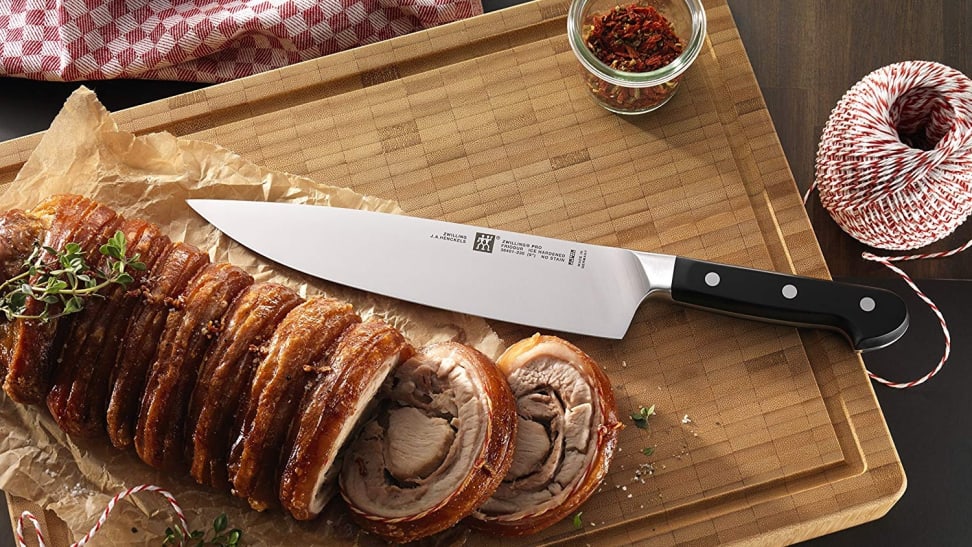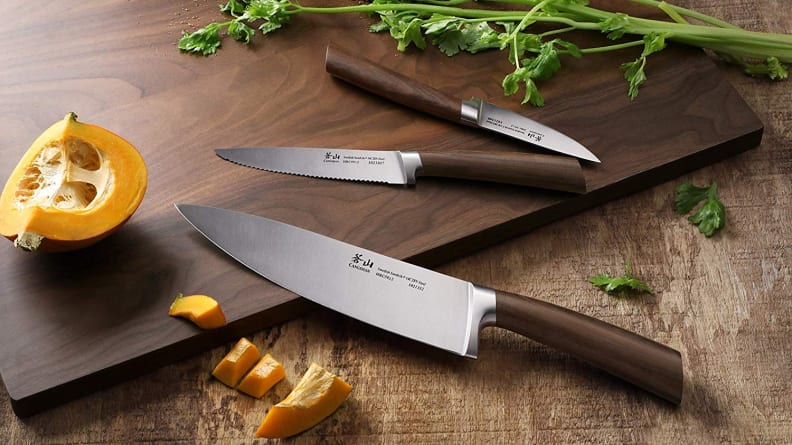 Credit:
Zwilling
Credit:
Zwilling
Recommendations are independently chosen by Reviewed's editors. Purchases made through the links below may earn us and our publishing partners a commission. Prices were accurate at the time this article was published but may change over time.
If I were an ancient pharaoh who got to be buried with her favorite earthly possessions, I’d pick my Dutch oven, chopping block, and J.A. Henckels chef’s knife. There's something about owning solid, high-quality kitchen knives that makes you feel unstoppable. Until I owned my first grown-up knife, I thought sweet potatoes were impossible to chop and avoided them at all costs—I pictured industrial kitchens using potato guillotines to get the job done.
If you're on the hunt for a new knife, be it a chef's knife, paring knife, bread knife, or something else, it's important to consider what, exactly, makes a good knife. Yes, sharpness is important, but it ultimately comes down to material, design and upkeep.
What's the best knife material?

Knives made from certain metals tend to be high-quality.
Most kitchen knives are made from metal, but occasionally you can find high-quality knives made from ceramic. Overall, the best kitchen knives tend to be made from one of the following materials.
Carbon steel
Our favorite chef’s knives are forged from carbon steel, which is a component made from a metal alloy consisting of the two title elements. The carbon makes the steel much stronger and more durable, so unlike other metals, it won’t bend easily and will hold its sharp edge for much longer.
Carbon steel knives are favorites among professional chefs, but there's one downside—this material is more prone to rusting, which means it requires careful care and maintenance.
Stainless steel
This is the most common element you’ll find in knife sets. Stainless steel is a less expensive metal that can still hold its own in the kitchen. It sharpens easily and can deliver a powerful chop, and unlike carbon steel, it doesn’t rust as easily. However, this metal is softer, meaning it may bend and needs to be sharpened more often.
Damascus steel
This metal alloy combines the hardness of carbon steel with the flexibility of stainless steel. The core is carbon, meaning you get the same durability and strength, but the exterior is stainless, so you get the flexibility and ability to bend.
Honestly, these knives often look really cool. Since they’re made of two metals folded together, makers can get creative with patterns. However, this all comes at a price—literally, these knives can get really expensive.
Ceramic
In some areas, ceramic knives outshine the competition—they’re incredibly sharp, lightweight and inexpensive, and they won’t rust and require little sharpening.
However, ceramic isn't as durable as other materials. These knives can easily chip or break, and they’re difficult to sharpen. For smaller knives, ceramic may be a good investment, but for your chef’s knife, stick to metal.
What are the characteristics of a good knife?

Look for these characteristics in your next knife.
Material isn’t the only thing you need to pay attention to when looking for a good kitchen knife. Several other factors come into play, from the size of the blade to balance of the knife itself.
Judge it by its size
Depending on the type of knife you’re shopping for, the size requirement will shift.
- Chef's knife: For a chef’s knife—your go-to blade for chopping vegetables and meat—you want about 8 inches, which makes it universally sized to cut just about anything.
- Paring knife: These smaller knives are perfect for precise tasks like deveining shrimp and cutting fruits, and they should be about 3.25 to 4 inches long.
- Bread knives: You’ll find the best serrated knives in the 8 to 10 inch range, the ideal size for slicing bread.
Watch the weight
A good knife definitely won’t be the lightest item in your kitchen, but it doesn’t have to be the heaviest either. There are differing schools of thought on whether the best knives are heavy or light, but ultimately, it needs to be the right weight for you. You don’t want to purchase a knife that’s too heavy to chop with, so find one that feels comfortable in your hand.
Embrace balance
There should be equal weight distribution between the handle and the blade of your knife. If you find a knife that's too heavy in the blade, it will be uncomfortable to use; one too heavy in the grip will deliver uneven and less effective cuts. Hold the knife in your hand before purchasing to ensure its weight distribution is just right.
Prioritize comfort
Some high-quality knives are made entirely from steel, from the blade to the handle, and while they look sleek, they aren't always the most comfortable to hold. You’re going to use your kitchen knives on a near daily basis, so make sure you like how the grip feels. Don’t buy one that will leave you in discomfort!
How to keep your knives in good condition

Proper maintenance will ensure your knife is never dull.
Once you’ve found and purchased a new knife, it’s up to you to ensure your tool stays just as fresh as the day you bought it. Follow these easy knife care tips for best results.
Sharpen often
First thing's first: invest in a high-quality knife sharpener because you’ll be conditioning your blade frequently.
How often should you sharpen? It depends on the material. For ceramic knives, you almost never need to sharpen. Damascus steel will depend on the manufacturing, so check the instructions that come with your knife. Stainless and carbon steels will require more frequent sharpening.
Store with intention
Please don't store your knives loosely in a drawer. Alton Brown prefers a magnetic strip, but you can also use a knife block.
However you store them, make sure your knives can’t knock against anything else in the kitchen, like spatulas, spoons or other fun kitchen gadgets. These will grind against the blade and leave you with a dull knife.
Hand wash every time
Your knives may say they’re dishwasher safe, but you’ll find more success when hand-washing kitchen knives. Handles made from non-metal ingredients may degrade over time in the dishwasher, and the blades themselves may be more prone to rusting when put through the harsh cycle. Experts recommend hand washing and cloth drying your knives immediately after use.
Get a high-quality cutting board
Even if you take the best care of your knife and sharpen it every day, you can quickly ruin the blade if you’re chopping on a low-quality cutting board. Wood and marble boards are best—plastic shouldn’t be your top choice, but glass should be your absolute last. If you need some guidance, check out our guide to the best cutting boards.
When you follow these tips, you'll be able to find the knife of your dreams—a match made in kitchen heaven! Now go forth and chop those sweet potatoes.





